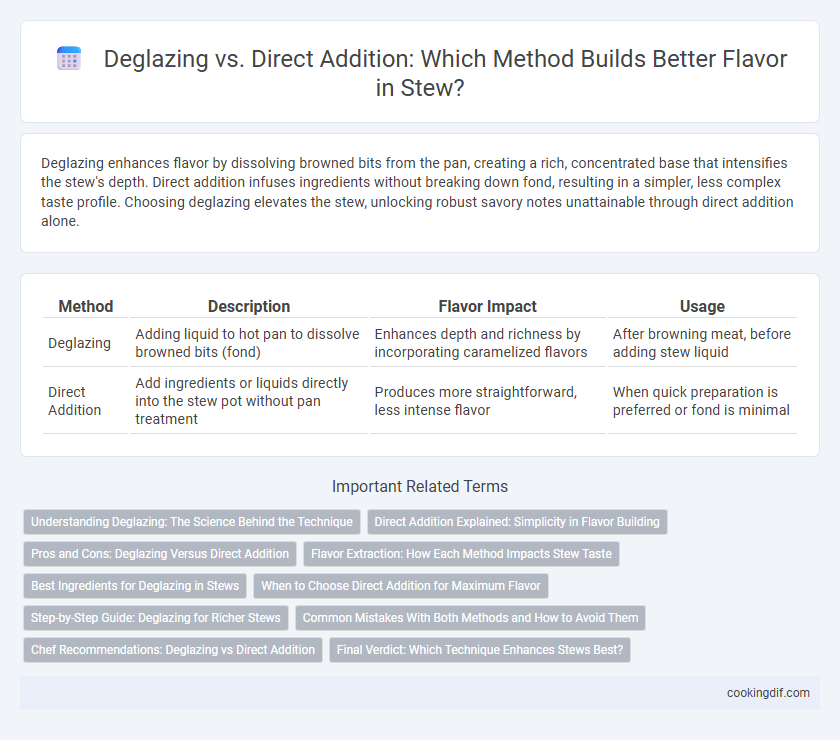Deglazing enhances flavor by dissolving browned bits from the pan, creating a rich, concentrated base that intensifies the stew's depth. Direct addition infuses ingredients without breaking down fond, resulting in a simpler, less complex taste profile. Choosing deglazing elevates the stew, unlocking robust savory notes unattainable through direct addition alone.
Table of Comparison
| Method | Description | Flavor Impact | Usage |
|---|---|---|---|
| Deglazing | Adding liquid to hot pan to dissolve browned bits (fond) | Enhances depth and richness by incorporating caramelized flavors | After browning meat, before adding stew liquid |
| Direct Addition | Add ingredients or liquids directly into the stew pot without pan treatment | Produces more straightforward, less intense flavor | When quick preparation is preferred or fond is minimal |
Understanding Deglazing: The Science Behind the Technique
Deglazing involves adding liquid, such as stock or wine, to a hot pan to dissolve browned food residues called fond, which are rich in concentrated flavors created through the Maillard reaction during searing. This technique not only helps lift caramelized bits from the pan but also infuses the stew with complex, deep layers of taste that enhance overall richness. Understanding the chemical process behind deglazing allows cooks to maximize flavor extraction and create a more savory and well-rounded stew.
Direct Addition Explained: Simplicity in Flavor Building
Direct addition in stews involves adding liquids or seasonings directly to the pot without first deglazing, creating a straightforward method for flavor building. This technique preserves the natural essence of ingredients while allowing the stew to develop depth through slow, consistent simmering. Chefs often prefer direct addition for its simplicity and ability to maintain a clean, robust flavor profile.
Pros and Cons: Deglazing Versus Direct Addition
Deglazing enhances stew flavor by dissolving caramelized bits from the pan, adding depth and complexity, but it requires extra time and a liquid like wine or broth, which can alter the stew's consistency. Direct addition of ingredients simplifies the process and maintains a more consistent texture, though it may result in a less intense flavor profile without the nutty, browned notes created through deglazing. Choosing between deglazing and direct addition depends on balancing desired flavor intensity against cooking time and ingredient control.
Flavor Extraction: How Each Method Impacts Stew Taste
Deglazing enhances stew flavor by dissolving browned fond from the pan with liquid, extracting complex savory compounds that enrich the broth. Direct addition of ingredients releases their natural juices gradually, resulting in a more layered and subtle taste profile. Combining both methods maximizes flavor depth by integrating intense caramelized notes with the stew's inherent freshness.
Best Ingredients for Deglazing in Stews
Deglazing with high-acid liquids like dry white wine, sherry, or apple cider vinegar effectively lifts browned bits from the pan, intensifying the stew's flavor profile. Using hearty broths such as beef or vegetable stock adds depth and enriches the stew without overpowering the main ingredients. Incorporating aromatic liquids like tomato juice or a splash of brandy elevates the complexity, making these the best ingredients for enhancing stews through deglazing.
When to Choose Direct Addition for Maximum Flavor
Direct addition is ideal when using robust, slow-cooking proteins such as beef or lamb, as it allows flavors to meld deeply during the long simmer. Opt for direct addition when you want the stew's ingredients to fully integrate, releasing their natural juices and intensifying the overall taste profile. This method excels with hearty vegetables like root vegetables and mushrooms that benefit from extended cooking to maximize flavor absorption.
Step-by-Step Guide: Deglazing for Richer Stews
Deglazing enhances stew flavor by dissolving caramelized browned bits from the pan with liquid such as wine, broth, or water, enriching the sauce with complex umami. Begin by sauteing meat and vegetables until browned, then pour a small amount of deglazing liquid into the hot pan, scraping with a wooden spoon to lift the flavorful fond. Incorporate this mixture into the stew pot to build depth and intensify the overall richness compared to direct liquid addition.
Common Mistakes With Both Methods and How to Avoid Them
Deglazing often leads to burnt bits if the pan isn't properly deglazed with enough liquid, causing bitter flavors; to avoid this, add wine or broth gradually while scraping gently. Direct addition can dilute the stew if excessive liquid is added too early, resulting in a weak flavor profile; control the amount of liquid and allow ingredients to brown sufficiently before adding liquids. Both methods require balancing heat and timing to maximize flavor extraction without overpowering the dish.
Chef Recommendations: Deglazing vs Direct Addition
Chef recommendations favor deglazing for building stews with complex flavors, as it dissolves browned fond from the pan, enriching the base with caramelized taste compounds. Direct addition of liquids can be used for convenience but may result in a less concentrated flavor profile. Culinary experts suggest deglazing with broth, wine, or vinegar to enhance depth and balance in stew recipes.
Final Verdict: Which Technique Enhances Stews Best?
Deglazing with wine or broth lifts the fond--the caramelized bits stuck to the pan--infusing stews with deep, complex flavors and richer umami notes. Direct addition of liquids simplifies the process but often lacks the concentrated intensity achieved through deglazing. For the most flavorful stews, deglazing consistently enhances depth and complexity, making it the preferred technique among chefs.
Deglazing vs Direct Addition for building flavor Infographic

 cookingdif.com
cookingdif.com